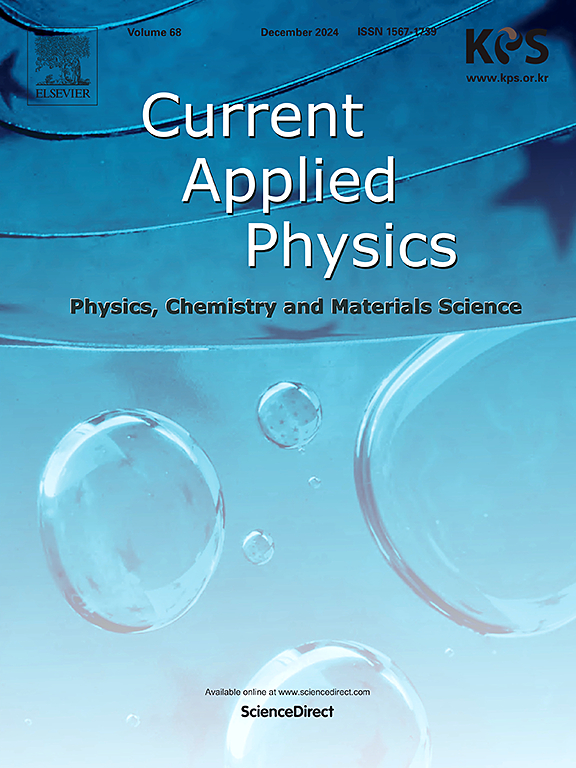TMAH预处理制备AlGaN/GaN HEMT及质子辐照电特性分析
IF 3.1
4区 物理与天体物理
Q3 MATERIALS SCIENCE, MULTIDISCIPLINARY
引用次数: 0
摘要
在本研究中,我们分析了质子辐照和表面预处理对氮化镓(GaN)基高电子迁移率晶体管(hemt)的影响,并评估了它们在质子辐照下的可靠性。通过5 × 1013 cm−2质子能量为15 MeV的辐照,分析了AlGaN/GaN HEMT直流性能的变化。在预处理过程中,分别用三甲基铵(TMAH)溶液处理活性区和平台隔离区(样品1)和平台隔离区(样品2)。并比较了质子辐照前后传递特性的变化。在质子辐照前后的传递特性上,质子辐照后由于片电阻和接触电阻的增加,漏极电流减小。此外,质子辐照在AlGaN/GaN表面产生了受体样和供体样空位,引起位移损伤效应。特别是,与质子辐照后样品1中的TMAH处理相比,样品2中TMAH处理的电流(Ion)变化增加了7.26个百分点(%p)。干刻蚀和等离子体增强化学气相沉积(PECVD)等离子体造成的损伤增强了质子辐照效果,因为TMAH溶液由于SiN沉积而没有完全处理AlGaN/GaN表面。这些结果表明,GaN基HEMTs的辐射硬度受AlGaN/GaN表面质量的影响,必须使用TMAH溶液进行预处理,以提高其抗质子辐照能力。本文章由计算机程序翻译,如有差异,请以英文原文为准。

Fabrication of AlGaN/GaN HEMT using TMAH pre-treatment and analysis of electrical characteristics by proton irradiation
In this study, we analyzed the effects of proton irradiation and surface pre-treatment on gallium nitride (GaN)-based high electron mobility transistors (HEMTs) and evaluated their reliability against proton irradiation. The variation in DC performance of the AlGaN/GaN HEMT was analyzed by irradiating a proton energy of 15 MeV at proton fluence of 5 × 1013 cm−2. During the pre-treatment process, the active region and mesa isolation region (Sample 1) and mesa isolation region (Sample 2) were treated with trimethylammonium (TMAH) solution, respectively. And the variation in transfer characteristics of before and after proton irradiation were compared. In terms of transfer characteristics of before and after proton irradiation, the drain current decreased after proton irradiation due to increase the sheet resistance and contact resistance. Also, acceptor-like and donor-like vacancies were generated on the AlGaN/GaN surface due to proton irradiation, inducing the displacement damage effect. In particular, the variation in on current (Ion) increased by 7.26 percentage point (%p) when TMAH treatment in the Sample 2 compared to when TMAH treatment in the Sample 1 after proton irradiation. The damage caused by dry etching and plasma-enhanced chemical vapor deposition (PECVD) plasma enhanced the proton irradiation effect because the AlGaN/GaN surface was not completely treated by the TMAH solution due to SiN deposition. These results demonstrate that the radiation hardness of GaN-based HEMTs is affected by the AlGaN/GaN surface quality and pre-treatment using TMAH solution is necessary to increase the resistance to proton irradiation.
求助全文
通过发布文献求助,成功后即可免费获取论文全文。
去求助
来源期刊

Current Applied Physics
物理-材料科学:综合
CiteScore
4.80
自引率
0.00%
发文量
213
审稿时长
33 days
期刊介绍:
Current Applied Physics (Curr. Appl. Phys.) is a monthly published international journal covering all the fields of applied science investigating the physics of the advanced materials for future applications.
Other areas covered: Experimental and theoretical aspects of advanced materials and devices dealing with synthesis or structural chemistry, physical and electronic properties, photonics, engineering applications, and uniquely pertinent measurement or analytical techniques.
Current Applied Physics, published since 2001, covers physics, chemistry and materials science, including bio-materials, with their engineering aspects. It is a truly interdisciplinary journal opening a forum for scientists of all related fields, a unique point of the journal discriminating it from other worldwide and/or Pacific Rim applied physics journals.
Regular research papers, letters and review articles with contents meeting the scope of the journal will be considered for publication after peer review.
The Journal is owned by the Korean Physical Society.
 求助内容:
求助内容: 应助结果提醒方式:
应助结果提醒方式:


